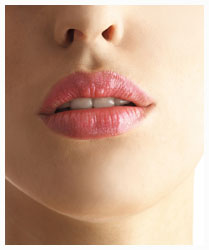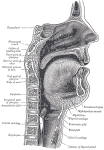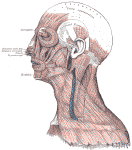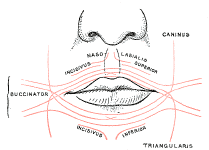Lip Anatomy Lips – we're mesmerized by their scarlet hue and caressed by their silky softness. The eyes may be the windows to the soul, but beautiful lips are definitely the gateway to sensuality, as Shakespeare's Romeo attests during his first encounter with Juliet: "My lips, two blushing pilgrims, ready stand Perhaps the fair Juliet's focus was on her suitor's lips, fascinated by their infinite movements as they performed a vocal dance of courtship. Even a girl as young as she would have noticed (or at least imagined) their sensual qualities long before they met hers. But we digress . . . Anatomy of the LipsLips are one of the most visible of all human organs and perhaps the most emotionally expressive part of the human body, so it's hardly surprising that lip enhancement has become so popular. Soft, protruding, and pliable, they are also multi-functional, providing an opening for food and beverage consumption, an instrument of both verbal and non-verbal communication, a tactile sensory organ and an erogenous zone. Three aspects of the lips vary in men and women and by geographic population: size (full or thin), curvature (sinuous or straight) and eversion (turning out or in). All three can be modified through lip enhancement surgery. Lips are composed of skin, muscle and mucosa – no bones and no infrastructure, making them unique pliable. The upper lip (Labium superioris) is superior in name only since it is actually somewhat smaller than its partner, the lower lip (Labium inferioris). The most cosmetically apparent portion of the lip is the vermilion border, or simply vermilion. This colored border between the lips and the surrounding skin exists only in humans. Rounding out the lip glossary are the philtrum (the vertical groove on the upper lip that forms the so-called “Cupid's bow” and gives the lip its characteristic appearance) and the ergotrid (the stretch of skin between the upper lip and the nose). Two lip surfaces can be differentiated: the skin and the mucous membrane, or lining. The red line formed where the upper and lower lips meet marks the transition between the vermilion lip and the mucosal lip. The skin of the lips is categorized as stratified squamous epithelium, or flattened tissue cells arranged in layers. In actuality, the phrase “thin-lipped” applies to all of us (although it may not be considered a compliment by most). The skin of the lip is made up of 3 to 5 cellular layers and is very thin compared to the skin on the rest of the face, which typically runs up to 16 layers deep. The mucous membrane of the lip is full of capillaries (tiny blood vessels) that are close to the translucent surface, giving it a reddish color. The lips are also somewhat fragile when compared to other areas of skin on the body. With no hair, sweat glands or sebaceous glands of their own, they lack the usual protective layer of sweat and body oils that keeps skin smooth, kills pathogens and regulates warmth. That's why lips tend to dry out faster and become chapped more easily.  Lips are controlled by their own muscles, which are considered part of the muscles of facial expression. The specific muscles acting on the lips are the sphincters of the oral orifice (orbicularis oris and buccinator), modiolus (anchor point for several muscles), muscles that raise the lips (levator labii superioris, levator labii superioris, alaeque nasi, levator anguli oris, zygomaticus minor and zygomaticus major) and muscles that lower the lips (risorius, depressor anguli oris, depressor labii inferioris and mentalis).  The principal lip muscle is the orbicularis oris, a concentric band of muscle that is suspended from the aforementioned surrounding muscles. This sphincter is made up of the pars marginalis (beneath the margin of the lips themselves, and uniquely developed in humans for speech) and pars peripheralis (around the lips' periphery from the nostril bulbs to the chin.) Lip movement is directed by the orbicularis oris and by the muscles in the upper and lower lips, making them extremely expressive of as well as multi-functional. For example, in addition to their gustatory function, lips can close the mouth airtight, keeping out unwanted objects. When narrowed into round shape like a funnel, suction can be applied – the basic function that allows babies to breastfeed or suck from a bottle. Infants also use their lips extensively to explore their world, mouthing objects and making sounds that mimic speech. As we mature, lips telegraph our changing range of emotions like no other body part can, from anger to joy, laughter to grief, and disappointment to exhilaration.  The lips' ability to carry out many functions may be attributable to the fact that the human brain devotes an unusually large part of its surface area to lips. It adds precision to lip movements through nerve fibers linked to the primary motor neocortex, the area of the brain that handles the higher functions of sensory perception, generating motor commands, spatial reasoning, conscious thought and language. Sensation in the upper lip is courtesy of the infraorbital nerve and branches of the trigeminal nerve, the largest of the cranial nerves. It is responsible for sensation in the face as well as motor functions, including biting, chewing and swallowing. The lower lip is served from the mental nerve and the perioral muscles are innervated by the facial nerve. The latter supplies the muscles of facial expression, including specific muscle fibers of the lips that control the pouting, curling and tightening movements that often unintentionally reveal our moods. It has been noted that our ability to whistle a tune is testament to our lips' “high IQ as neurological smart parts.”  The blood supply for the lips comes from the superior and inferior labial branches of the facial artery, one of the six non-terminal branches of the external carotid artery. More than just supplying nutrients to lip tissue, blood also figures prominently in lip color. Light-colored skin contains no melanocyte (pigment cells) and consequently the underlying blood vessels appear through the skin on the lips. The effect is less prominent in the case of darker skin, which contains more melanin and is visually thicker. Lips are packed with nerve endings, making them a highly erogenous zone (ergo the popularity of kissing). The concept of lips as sex object is based as much on their visual allure as it is on their sensitivity to touch. Scientists in Scotland have given credence to the long-held belief that a woman's lips are a highly visible expression of her fertility and sexuality. The sexual psychologists tested dozens of women to determine their estrogen levels and found that those with higher levels of the sex hormone linked to fertility also had more feminine features, including fuller lips. The researchers then showed the pictures of the women to a group of men who rated the women for health, femininity and attractiveness. It turned out that the men gave the highest marks to the women who tested highest for estrogen. “In our evolutionary past, men who favored women with feminine features would be choosing the more fertile female, and thus would have had more babies and be passing on more of their genes,” explains Miriam Law Smith, who helped conduct the study. She also postulates that women wear makeup (or employ other means of enhancement, including lip surgery to highlight the facial features most closely associated with heightened fertility and sexuality – and beautiful lips rank near the top of that list. Dry, Chapped and Flaky Lips: The Perfect Way To Ruin A Perfect PoutAs already noted, our lips are very different from the skin on our bodies and faces, which have many more layers, glands, pores, follicles and melanin, which allows us to tan as a natural reaction to sun exposure. This melanin screens the harmful UVA/UVB rays, meaning that people with higher melanin (darker skin) are less likely to develop a sunburn than their fair-skinned counterparts. Lips do not produce much melanin, making it important to always use a moisturizing product with an SPF (sun protection factor) of at least 15, although I recommend much higher than that.
Many of you may notice that your lips become dry when you are in bed with the flu or have allergy problems. Oftentimes this is due to fever, dehydration and mouth-breathing. Just be sure to coat your lips often with a good lip product and drink plenty of fluids, which you should be doing anyway. If you are looking for ways to maintain your smackers at their peak, visit our Lip Maintenance page for some pointers. This section contains lip enhancement tips on how to keep your lips smooth, flake-free and soft, as well as moisturized and protected. If you have any lip care or product recommendations, we'd love to hear from you, so drop us a line! |

